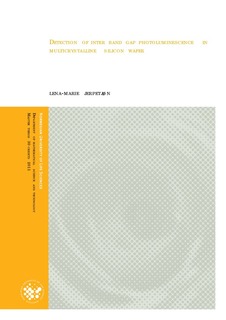Detection of inter band gap photoluminescence in multicrystalline silicon wafer
Master thesis
Permanent lenke
http://hdl.handle.net/11250/188718Utgivelsesdato
2011-09-30Metadata
Vis full innførselSamlinger
- Master's theses (RealTek) [1722]
Sammendrag
Measurements executed at 300 K revealed photoluminescence solely from silicon. However, at 93 K the measurements revealed photoluminescence from both silicon and defects. The detected photoluminescence signal of silicon at 93 K was stronger though spectrally narrower than the signal detected at 300 K. Hence, the photoluminescence signal was affected by multi-phonon interactions. Two features, D1 and D2, were detected among other defects at 93 K. These two features have been put in relation to dislocation networks. Defect photoluminescence were detected at a lower energy range than photoluminescence from silicon. Defect photoluminescence were detected as point defects, grains, and large dislocation structures. Elements such as iron, nickel, copper, chromium and several others are assumed to give rise to the detected photoluminescence. Principal component analysis of the datasets recorded at 93 K and 300 K revealed the same spectral features of silicon and defects as the photoluminescence imaging technique. Inter band gap photoluminescence were detectable with the photoluminescence imaging technique employed when the wafer was frozen at 93 K. The technique for photoluminescence imaging has proven to be a fast and nondestructive way to detect inter band gap photoluminescence, caused by defects in multicrystalline wafers. This technique can be applied to analyze defects in wafers before constructing the finished solar cell to achieve a higher efficiency to be more attractive on the solar cell market.
